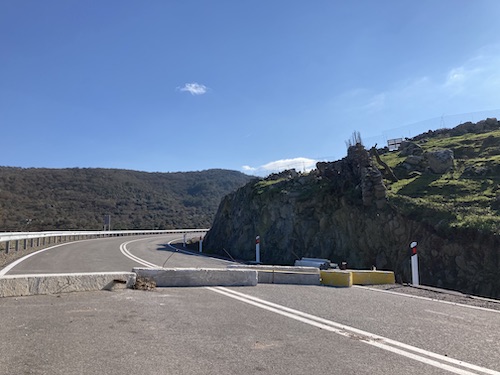(Road block at the beginning of the new road at Filia)
Greeks have never been good road builders: true in the past and today. The word asphalt may come from the Greek asphaltos, but in Ancient Greece paved roads were rare. The most famous was the Holy Road, which lead from Athens to Eleusis; where once a year hundreds of participants used to go walking, dancing or running to the Elysian Games.
Greece has always been a seafaring nation and it preferred to transport goods over water. Up until the time of the car, Lesvos’ main transport also took place by sea. When for example in the middle of Nineteenth century you wanted to go from Molyvos to Mytilini, you would take the ferry Kavalla, Imbros, Tenedos, Molyvos, Mytilini and on to Smyrna. In the novel The Mermaid Madonna the Lesvorian author Stratis Mirivilis writes about a man from Sykaminia who sailed with his little boat to the big town of Mytilini and returned so drunk that he didn’t notice a stowaway in his boat.
However, not everything was to be reached over the waves. To go to Agiasos, you had to climb on a horse or a donkey, then trudge over mostly sandy roads, but also over little paved paths that meandered through the landscape, until finding yourself deep into the mountains. These were the small monopatia and the somewhat broader and paved kalderimia that connected the mountain villages: some parts of those old paths on the island are still popular with hikers. They bring you along magic landscapes, other parts are buried under asphalt roads.
More than once you will be surprised (or disappointed) by another road bituminized, though Lesvos still has many unpaved roads, dirt roads that lead to all the far away corners of the island. Each mountain top can now be climbed by a jeep and the extensive woods with their network of dirt roads offer plenty of opportunity to get lost.
The older roads of mountainous Lesvos consist of plenty of curves. The art of building a new road is to get it as straight as possible, as happened to the new road around Agios Dimitrios, near Agiasos. This small hamlet with its tavernas and sweet fruit and vegetables (koutalio glyko) can now only be reached by the tortuous ‘old road’, a beautiful street along the canyon and the old soft drink factory.
The most problematic road on the island is the one ‘under construction’, from Sigri to Kalloni. At the Sigri end, the road climbing up the mountain was finished more than ten years ago and might now need some renewing. A little further along the route, the regular findings of sensational petrified trees have slowed down the progress, leaving you with the impression you are in an open air museum. The part along the canyon a little before Vatoussa has been pretty quickly widened and, I must admit, this intensive building hasn’t much harmed the magnificent nature there.
The stretch Vatoussa to Skalachori seems to have been finished for years, but it still not ‘officially’ opened. The ‘forbidden’ entrance signs however are ignored by lots of drivers who utilise this beautiful road like it was already blessed and opened by a priest.
The Skalachori to Filia stretch (towards the Limonos monastery in the direction of Kalloni) was finished not many years ago. Last year here you also had the opportunity to ignore the ‘forbidden’ entrance signs and to discover this new road with its splendid views that will certainly distract many a driver. After just six months however the road was closed off and now lies there all alone.
The section intended to direct travellers around Dafia and Kalloni seems to be ready to open but is heavily blocked, making it still impossible for curious drivers to reach the road. One of the reasons is the stupid design for its crossroad with the Petra to Molyvos road . Elsewhere they have introduced roundabouts to the Lesvorian road system but here some crazy person loving the most dangerous crossings of the world seems to have been the planner – Caboom! Even a child can see that this crossing can’t possibly be given a green light. Of course nobody takes responsibility and the road will continue gathering dust.
It took more than ten years to get nature and its inhabitants on their knees to build this road. Contractors who fled with the money; landowners who didn’t want to sell (and when they did – never saw the money); sensational findings of petrified trees; inhabitants of Kalloni, (addicted to exhaust fumes) who feared that when traffic no longer raced through the town center, all shopping would end: all ingredients for an exciting series on Netflix. According to local papers, the road will finally be opened in March and then, at last, we can make new speed records when driving from Kalloni to Sigri. But . . . First – see, then – believe.











